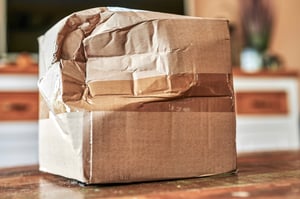You’ve been anticipating a package for days. Yet when it finally arrives, you notice it’s damaged, much to your dismay. Talk about a letdown!
Transit damage is a common occurrence in shipping and logistics. Mishandling of shipments in the fulfillment process, relentless vibrations during shipment transportation, or extreme temperatures or weather conditions can lead to transit damage and even lost or inaccurate shipments.
As a result, transit damage can make a significant impact on your ecommerce business. Not only do you run the risk of your customers rejecting shipments entirely, you could have to deal with the ramifications of time-consuming freight claims to recoup costs (which can take months to resolve). Other factors that can affect your company due to transit damage include:
- Lost productivity from managing returns and re-shipping items
- Decreased customer satisfaction and loyalty
- Damaged brand image and company reputation
While you can never eliminate transit damage entirely from your supply chain, there are vital steps you can take now to prevent unwanted transit damage during future shipments.
Protect Your Shipments from Transit Damage with These Six Key Strategies
Utilize the Right Packaging:
Keeping your products safe in transit starts with something simple yet crucial: your packaging. Prioritize shipping box dimensions that properly fit the products inside, with just enough space to include packing material for protection from transit damage.
These boxes should also be made of sturdy materials. Stick with boxes that maintain structural integrity for the product’s weight and when stacked with others in various stages of the shipping process. Depending on the size and weight of your products, you may even need to consider wooden crates to reduce the potential for transit damage.
Seal your Packages Correctly:
You must also consider the packing tape used to properly seal your packages, whether they’re bubble wrap mailers, boxes, or something more unique. There are a variety of strong adhesives designed for specific shipping needs, so it is important for your business to choose the one that works best for the unique item. Examples include acrylic (or carton sealing) tape, hot melt tape, cold temperature tape, and water-activated tape.
In this case, one size does not fit all! Rather than selecting one type of packaging or sealing for all your brand’s shipments, choose the ideal option for each unique item.
Apply Proper Labeling:
Package mishandling is a major cause of transit damage. However, labeling your packages is a great way to prevent said mishandling. Directional labels should be displayed prominently in multiple places. These labels often include warnings such as “Fragile,” “Keep Frozen,” and “This Side Up,” to name a few, giving package handlers the guidance they need to keep shipments moving safely.
Other important labels include freight barcode labels, terms and conditions, and bills of lading, which should all be easily displayed for handlers as well.
Add Packing Materials for Impact Protection:
With your product in boxes, there’s often empty space inside that can lead to transit damage if left unfilled. Lightweight packing materials like styrofoam or bubble wrap can secure your items from shifting during transit, as well as provide a protective barrier to reduce impact in case packages are ever dropped or fall from shelves. Certain materials will perform better than others depending on the size of the package and the items shipped.
Use Quality Pallets:
The pallet is a key tool for storing, organizing, and transporting freight. To avoid transit damage, you must stock your warehouse with first-rate wood or plastic pallets that can reliably carry heavy loads.
Your team should inspect each pallet before use to ensure your loads don’t break due to damaged or poorly made pallets, especially if you reuse pallets to reduce environmental impact. Once inspected, each pallet should be stacked properly without gaps or boxes hanging over edges. Shrink wrap and corner protectors can secure pallet loads during transit as well.
Separate Shipment Types for Efficient Loading:
Strategically arranging and loading shipments into trailers is necessary to prevent transit damage. Start by separating liquid and fragile shipments from other item types, as these are often mostly likely to incur transit damage. Liquids are typically placed on the bottom of trailer loads in case of leaks while fragile items are stored on top of other packages (or in some cases, fortified with crates).
You should also load each trailer efficiently, with weight evenly distributed. This also means reducing gaps between pallets or packages as much as possible to cut down on items shifting during transit.
A Reliable 3PL: The Ultimate Transit Damage Prevention
Though accidents happen, deploying these strategies can help make transit damage less prevalent in your supply chain. Yet perhaps your most important strategy for preventing transit damage is to partner with a reliable 3PL for your shipping and logistics needs. At Smart Warehousing, we’re experts at shipping your products safely and responsibly, making transit damage in your company a thing of the past. Contact us today to learn more.


